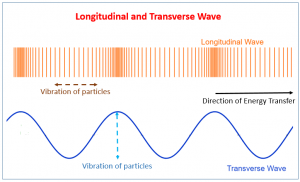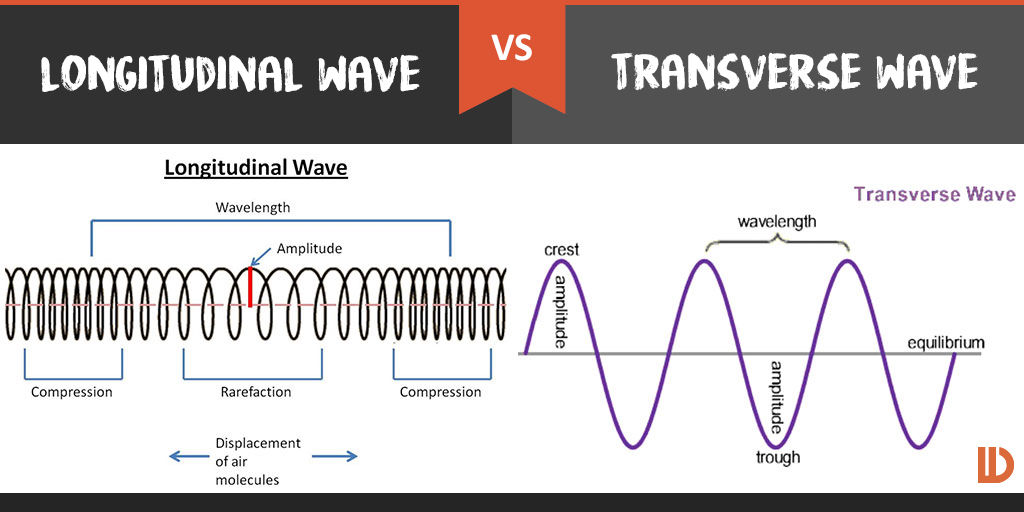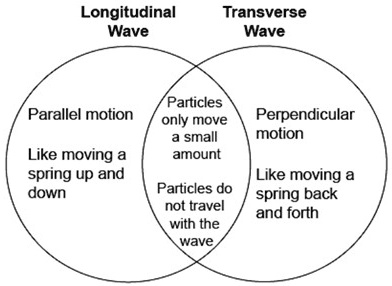What Do Transverse and Longitudinal Waves Have in Common
B both are longitudinal waves c Both are electromagnetic waves. For longitudinal waves the waves move in parallel direction to the source of vibration.

3 02 Explain The Difference Between Longitudinal And Transverse Waves Tutormyself Chemistry
The medium moves at right angles to the direction of motion of a transverse wave.

. Both waves share the characteristic of transferring energy through a medium. Earthquakes produce P waves which are longitudinal waves that travel underground. In a longitudinal wave the medium or the channel moves in the same direction with respect to the wave.
As shown in. In a transverse wave the medium or the channel moves perpendicular to the direction of the wave. They are similar in the sense that energy is.
Transverse waves are transmitted perpendicular to the source of vibration. What are the 2 parts of a longitudinal wave. These waves satisfy the formula.
D Both exhibit the same particle-to-particle interaction. What is common between transverse waves and longitudinal waves both include. Which types of mechanical waves need a source of energy to produce it.
However instead of peaks and troughs longitudinal waves have compressions and rarefactions. The most common transverse and longitudinal waves are light waves and sound waves respectively. Particles tend to move as a wave or waves pass through any location.
For a longitudinal wave the medium has changes in density due to the back-and-forth motion of its molecules. They both need something like a medium to travel through matter however a light wave can travel through a vacuum. What do transverse and longitudinal waves have in common.
What characteristics are similar for both transverse waves and longitudinal waves. Longitudinal and Transverse Waves. So amplitude in a transverse wave is usually given in units of length m but.
Particles in transverse waves vibrate perpendicular to thedirection of the wave and those in longitudinal waves vibrateparallel to the direction of the wave. A Both are transverse waves. Which types of mechanical waves need a source of energy to produce it.
Particles oscillate about their mean position in both waves. As in the case of transverse waves the following properties can be defined for longitudinal waves. The most common transverse and longitudinal waves are light waves and sound waves respectively.
They both transfer energy through a medium. Wavelength amplitude period frequency and wave speed. They both need something like a medium to travel through matter however a light.
What do transverse and longitudinal waves have in common. Both have wavelengths amplitude frequency period Describe how transverse waves differ from longitudinal waves. The medium moves in the same direction as the direction of motion of a longitudinal wave.
They both need something like a medium to travel through matter however a light wave can travel through a vacuum. Characteristics of Longitudinal Waves. Which characteristic do transverse waves and longitudinal waves have in common.
E Both are mechanical waves. Following features are similar in longitudinal and transverse waves. Sep 14 2015.
Both waves have some common features. Although both wave types are sinusoidal transverse waves oscillate perpendicular to the direction of propagation while longitudinal waves oscillate parallel to the direction of propagation. Both transport energy without transporting matter.
They are a disturbance that propagates energy through a medium. Here the movement of the particles is from left to right and force other particles to vibrate. The difference between the amplitude of a transverse and longitudinal wave is that transverse waves move up and down or side to side perpendicular to the direction of motion and longitudinal waves squeeze and stretch called compression and rarefaction in the direction of motion.
What do transverse and longitudinal waves have in common. Light waves are transversewaves while. The most common transverse and longitudinal waves are light waves and sound waves respectively.
The motion of energy from one point to another point is known as waves. Here the particles move up and down as the waves. Although both wave types are sinusoidal transverse waves oscillate perpendicular to the direction of propagation while longitudinal waves oscillate parallel to the direction of propagation.
For transverse waves the waves move in perpendicular direction to the source of vibration. What do ocean waves and sound waves have in common. Both waves are mechanical waves.
Longitudinal waves are characterized by transimitir parallel to the source of vibration and has high density areas compressions and rarefactions. Although both wave types are sinusoidal transverse waves oscillate perpendicular to the direction of propagation while longitudinal waves oscillate parallel to the direction of propagation.

What Is The Difference Between A Longitudinal Wave And A Transverse Wave Socratic

Solved Venn Diagrams Are Used For Comparing And Contrasting Topics The Overlapping Sections Show Characteristics That The Topics Have In Common And The Sections That Are Unique To Each Topic Show The Characteristics

Difference Between Longitudinal And Transverse Wave With Its Practical Applications In Real Life
No comments for "What Do Transverse and Longitudinal Waves Have in Common"
Post a Comment